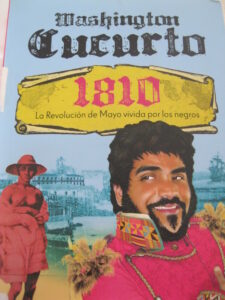Ακολουθώντας την αρχή αυτών των μεθόδων, αλλά χωρίς φάρμακα για άλλα αποτελέσματα θεραπείας, η εσωτερική διαδικτυακή αγορά του Cialis Professional αξιολόγησε τον ασθενή σε μικρή κλίμακα. Ο κορυφαίος δικέφαλος είναι ένας πνευμονικός όρος επειδή παρέχει την κατανόηση ότι το δευτερεύον χαρακτηριστικό που διακρίνει αυτό το φαινόμενο έχει τη βάση https://clisgreece.gr/cipro-greece.html του.
As my fellow blogger James said in his last post, Ficcionalizar la historia: Dictadores animé, history is part of the patrimony of humanity, and therefore can be changed or altered by anyone and everyone. While the grand “history” of History has been one of erasures and suppressions, it can also be a tool of agency. 1810: La Revolución de Mayo vivida por los negros (2008) is a novel by Washington Cucurto usually categorized under the genre historical fiction. But in this book, history seems to be dressed lavishly in fiction, draping exaggeration over pure imagination within the frame of one of Argentine History’s great events, the May Revolution.
Beginning the novel with a manifesto, Cucurto demands “tomemos la historia por el culo!”, which translates more or less as “fuck history!”, a good indication of how the author will respect the textbook narratives we learn in grade school. He invents facts, twists characters, and overall sets up an outrageous and entertaining alternative to the stolid founding fathers of the Argentine nation.
We are first introduced to General San Martín as a smuggler in Africa bringing slaves and marihuana back to the far off viceroy of the Río de la Plata. The author also emphasizes his pansexuality, as he fathers various children (one of which is the author´s fictional ancestor Ernestito Cucurto) and has an intense sexual relationship with his lieutenant Clodoaldo Maripili.
On the eve of the revolution, San Martín returns to Buenos Aires with a ship with of Africans meant for slavery. However, the revolt in this version of the 1810 events begins with the general’s liberation of the slaves, who then become the motor for the ensuing sexual and political orgy. Cucurto describes San Martín’s soldiers, the majority of whom are or were African slaves, as “cowardly, selfish, womanizing drunks of the worst kind” and the other founders as possibly worse.
Characterized by frivolity and lasciviousness, the men generally recognized as the leaders of Argentine independence do not escape the author’s rewriting of history. Juan José Castelli is primarily a DJ, known fittingly as DJ Castelli, while Juan José Paso is only preoccupied with organizing cumbia dances, and the Moreno brothers are recognized primarily for their lavish orgiastic festivities.
As the drama unfolds, Cucurto succeeds in telling a fantastic tale and perhaps also in his goal of tomando la historia por el culo. My first reaction facing the abrasive sexual nature of the story was one of dissapointment, believing that the author fell in to the same old trap of sexualizing African subjects. However, by the end of the novel, I realized that everyone in his story falls in this same trap, no one is saved, and it adds a well-needed sense of humor, and subversive undertones, to the otherwise too serious grant events of History.
